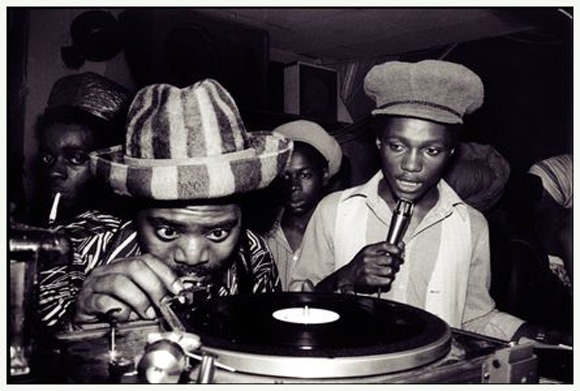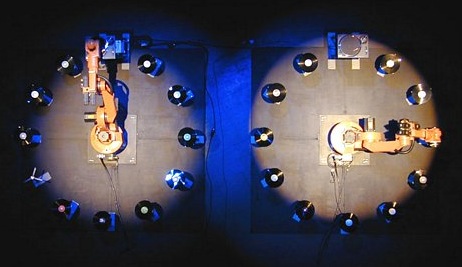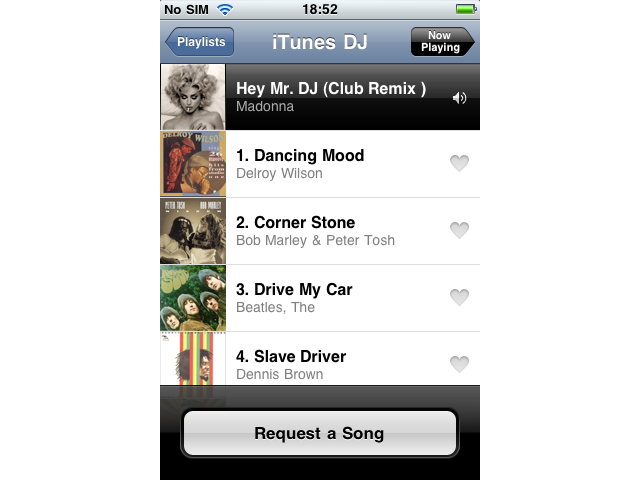Forget for a moment the narrowed technical concepts usually dealt with on this blog, to focus on the most fundamental interaction one has with their music on a daily basis … playing. How can this be impacted by software?
I’ll dissect my personal case and show you how I adjust my use of iTunes according to the role I want to play in the listening session.
Sunday driver

Photo credits: Bernard Sohiez @ UrbanImage
Before the mp3 era, media storage used to be pretty limited. The need to step in every time a disc finished, forced user to adopt a selector mindset, constantly thinking ahead of the next tracks to play.
It’s possible to mimic this old school selector behaviour in iTunes : browsing among the shoals of metadata, using a savvy combination of filters/requests, in order to extract from the mass the next song that will fit your playlist. But from a user experience standpoint, the cold interaction one has with a screen/keyboard can’t compete with the vintage charm of vinyl juggling on a turntable.
As a result, I rarely use iTunes to manually explore my library (unless I really feel the urge to listen to specific songs). I prefer to lose control in favor of a smoother user experience.
Passive passenger

Cutting loose from computer interactions is how I roll now (hosting iTunes on a headless Mac Mini, slashed of mouse and keyboard outgrowths, does help).
If you take this path, avoid a brutal break-up where your computer would be suddenly in charge of the mp3 kids. Indeed, the basic setup consisting of activating random mode, clicking play and praying for the best is rarely satisfactory. Selection based on pure randomness doesn’t cut it.
Some thorough work is needed to level up your computer into a decent stand-alone selector.
Because he is so clueless, you need to spoon-feed him with the best musical food you have, so he can chunder it later. Use smart playlists for this purpose. These dynamic playlists work by selecting songs that match a set of given criteria or thresholds. As usual, the solution means leveraging embedded metadata: no room for badly tagged files!
Define the smart playlist that will be the cornerstone of your daily music routine; only the songs matching its definition will be authorized to be played by your computer. Once your custom-made smart playlist is done, promote it as the source of your player’s built-in DJ mode (whether it’s named iTunesDJ, Auto-DJ or Automated Playlist Generator).
You gotta have well thought out criteria that encompasses a large amount of music files to see the main merit of smart playlists: resourceful selection that spans the entire spectrum of your tastes.
Backseat selector

My music totally controlled by a machine, with no consideration for my current mood or specific requests whatsoever. It sounds a bit too rigid, let’s see how to inject a dash of human judgment into the mix.
Keep in mind that simply accessing iTunes on my Mac Mini is not a satisfying option for me — too much friction involved. Well, without further ado, let me introduce you to Remote, the main reason why I bear with iTunes despite its shortcomings :
Remote is a free, fun, and easy-to-use app that turns your iPhone, iPad, or iPod touch into a remote control. So wherever you are in your house, you can control your computer’s iTunes library and your Apple TV with a tap or flick of a finger. Apple.com
(not much to add; using Remote just feels right, hardly describable. It’s just something you have to experience by yourself).
When you think about it, handling music selection via a mobile application is a natural fit. Compared to previous medias, modern digital storage enables music to be :
– mutable. Edit mp3 files to attach descriptive data (text, images) that can be displayed on a screen to provide context when the song is played.
– dematerialized. Access your music from anywhere using Internet or local Wi-Fi.
Remote shines by exploiting these two characteristics and delivering its features via a clean user interface that provides an unsurpassed user experience.
What’s next?
My conclusions are two-fold :
– software can improve the playing experience by reducing the burden of selecting songs thanks to smart playlists.
– using desktop software involves too much frictions and context-switches. Being able to control iTunes from my sofa using a mobile application has redefined my user experience for the better.
Lines are moving quickly after announcements of Amazon, Google and Apple to make personal music collections available from the Internet.
Coming months are promising, maybe soon I will be streaming my tunes from the Cloud, screaming out ‘MAKE IT RAIN!’ with pleasure … I doubt it though. In any case, I will keep you informed.